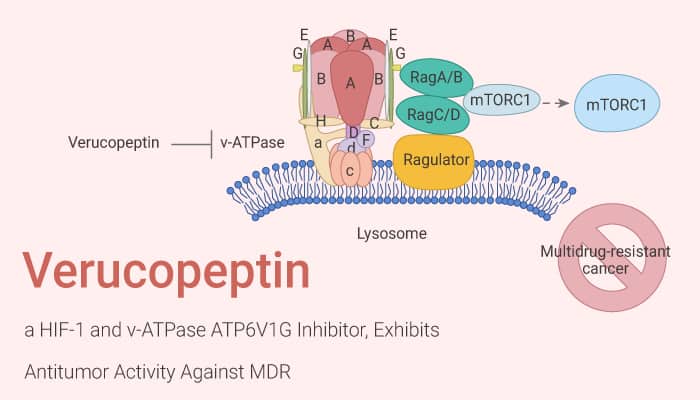ATP6V1G, a subunit of the vacuolar H+-ATPase (v-ATPase). In this article, we will introduce a potent ATP6V1G inhibitor, Verucopeptin.

Firstly, in vitro. Verucopeptin shows excellent antitumor activity against K562R cells, with an IC50 of 388 nM. Although these cells exhibit resistance to some other chemotherapeutic agents, such as Taxol and vincristine at concentrations of 10 μM.
Among a total of 1,094 cancer cell lines, Verucopeptin shows broad antiproliferative activity. The IC50 values of those cells are less than 100 nM against 66% of the cell lines evaluated. Moreover, Verucopeptin displays tissue specificity, such as leukemia, lymphoma, and melanoma, which are the lower IC50 groups. While other cancer types, such as non-small cell lung cancer are the higher IC50 groups.
Verucopeptin pretreatment blocks VE-P labeling of ATP6V1G1 but not ATP1V1B2 or ATP6V1D in a competitive binding assay. It shows substantial inhibition of v-ATPase activity. Meanwhile, this inhibitor suppresses lysosomal acidification in vitro, as does Baf A1, although to a lesser extent.
Verucopeptin exhibits substantial inhibition of p-S6K as well as p-4EBP1 at concentrations of 10-200 nM. Additionally, it attenuates the phosphorylation of most of the tested mTORC1 downstream substrates, including p-4EBP1, pmTORS2448, p-mTORS2481, p-Rictor, p-ULK1, and p-Grb10, at concentrations ranging from 50 nM to 500 nM.
Verucopeptin is also a potent HIF-1 (IC50=0.22 μM) inhibitor and decreases the expression of HIF-1 target genes and HIF-1α protein levels.
Verucopeptin decreases the HIF-1 protein level in a dose-dependent manner. But it has no effects on c-Raf in HT1080 cells. However, the known hsp90 inhibitor Tanespimycin inhibits both HIF-1 and c-Raf expression in cells.
In BALB/c nude mice by subcutaneous injection of SGC7901/VCR cells model. Verucopeptin substantially represses tumor growth without significant bodyweight loss or gross signs of toxicity. HE staining indicated that Verucopeptin potently induces cell death and abrogates mTORC1 signaling by dephosphorylation of S6K and 4EBP1.
Verucopeptin exhibits antitumor activity against multidrug resistance (MDR) cancers and can be used for cancer research.
Reference:
[1]. Yuezhou Wang, et al. Cell Chem Biol. 2020 Jun 30;S2451-9456(20)30234-8.
[2]. Nobuaki Takahashi, et al. Chem Commun (Camb). 2019 Oct 1;55(79):11956-11959.